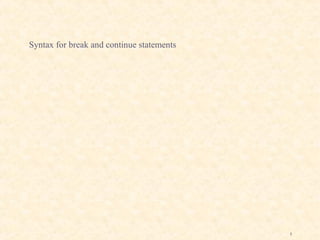
9 cm604.13
- 1. Syntax for break and continue statements 1
- 2. Objective • On completion of this lecture , you would be able to know • break and continue statements 2
- 3. Recap • In the previous class, we have discussed • various iterative statements 3
- 4. break statement •The break statement causes the program flow to exit from the body of the loop •In Java break statement is available in two types •Unlabeled break •Labeled break 4
- 5. Unlabeled break • This is used to control the program flow in a iterative statement structure / selective statement structure. • Syntax : break; 5
- 6. Unlabeled break Contd.. • In switch statement we use break, it causes the program flow exit from the body of the switch • If break is used in loop, control goes to the statement after the loop • If break is used in nested loops , control goes to the next outer loop 6
- 7. break Statement Contd.. test condition Break End of the loop Fig. 13.1 break statement 7
- 8. Example class testbr { public static void main(string args[]){ for (int j =10;j<=100; j=j+5){ if (j==50) break; System.out.println(j); } System.out.println(“Break enabled”); } } 8
- 9. Example Contd.. • In the above program , for loop is designed for 10 to100 with 5 increment, the break statement causes it to terminate before the final value of 100, when j equals to 50 9
- 10. Labeled break • The labeled break causes the execution to resume at the end of the labeled block Syntax: break label; 10
- 11. Labeled break Contd.. int n; read_data; while (…) { … for(…) { …. break read_data; … } } if( n<0) // this statement is executed immediately after the break { … } 11
- 12. The continue statement • The continue statement sends control to the top of the loop in which it occurs 12
- 13. The continue statement while ( expression ) { do { for ( expr1; expr2; expr3 ) { ... ... ... ... ... ... continue continue continue ... ... ... ... ... ... } /* for */ } /* while */ } while (expression); Fig. 13.2 continue statement 13
- 14. The continue statement Contd.. • In while and do while the continue statement causes control to be transferred directly to the conditional expression that control the loop • In for loop , control go to iteration position and then to the conditional expression 14
- 15. Continue Example for (int k=1; k<=10; k++) { if (k = =5) continue; System.out.println(k); } Value 5 is not printed Output : because of continue 1 2 3 4 6 7 8 9 10 statement 15
- 16. Labeled continue statement • Skips remaining statements in nested-loop body • Proceeds to the beginning of the specified labeled block 16
- 17. Summary • In this class , we have discussed, the following statements • break • continue • Labeled break • Labeled continue 17
- 18. Quiz 1.Continue statement can be used in control structure. [True/False] 18
- 19. Quiz 1.Continue statement can be used in control structure. [True/False] 19
- 20. Quiz 2.Break statement can be used in control structures. [True/false] 20
- 21. Quiz 2.Break statement can be used in control structures. [True/false] 21
- 22. Quiz 3.Break violates rules of structured programming [True/false] 22
- 23. Quiz 3.Break violates rules of structured programming [True/false] 23
- 24. Frequently Asked Questions • Differentiate between break and continue statements. • Explain about break and continue statement. 24
Editor's Notes
- Chapter 6 - Notice that the if–then statement is not necessary, because we can write any if–then statement using if–then–else by including no statement in the else block. For instance, the sample if–then statement can be written as if (testScore >= 95) { messageBox.show("You are an honor student"); } else { } In this book, we use if-then statements whenever appropriate.
- Chapter 6 -
- Chapter 6 -